SLR Lens Mount Identification Guide
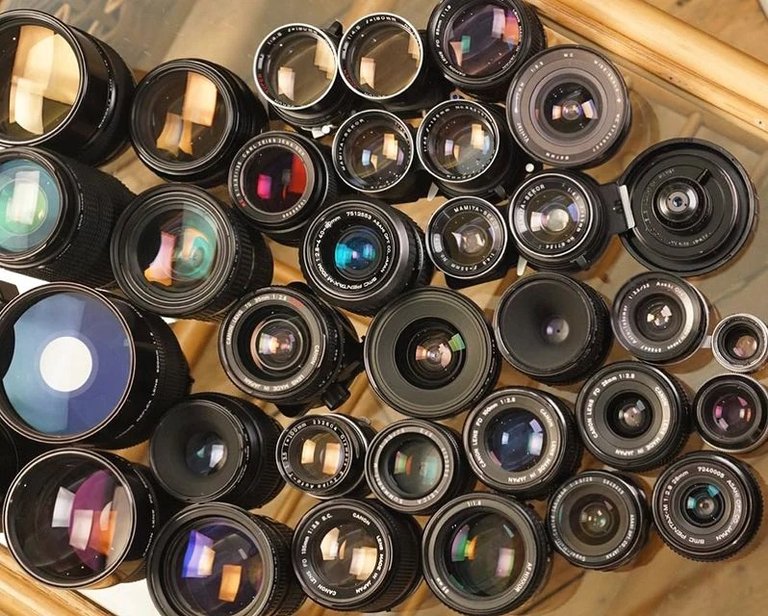
Source / Извор: wycameras.com
You have already had the opportunity to see from my texts that very good lenses from the analog era can be found at the flea market, for a minimal price. There is just one small problem…
If you decide, like I did, to look for pearls from the pre-digital age, you will inevitably come across a seemingly flawless lens, but – with an unknown lens mount. And then you will ask yourself a natural question: Is it possible to adapt this on my camera?
Therefore, we need a guide that will help us identify which system the lens belongs to, if it is not clearly marked on it – which is usually the case with third-party lenses. And since Internet text is an extremely ephemeral plant, which can disappear tomorrow, the best way to save useful things is to place them on a decentralized platform, such as our Hive. So, let’s see what can we present here…
Probably the most comprehensive photo library of lens mounts you will find at Robert Allen Kautz photo site. It is very well designed, and is therefore hard to be ‘translated’ into one page post. Link will get you there until it exists.
Wycameras has very well presented most common lens mounts from the great camera manufacturers: Nikon F (Ai, non-Ai, AF & AF-D), Canon FD (‘Breechlock’, New FD) & EOS EF, Pentax K (PK-M & PK-A) & M42, Minolta (MD & AF), Olympus OM, Contax/Yashica, Leica R, and Practica PB. Unfortunately, you will eventually get some exotic lens mount where this site won’t be of help.
Spec table you can find at Camera-wiki.org
You will certainly find more than few videos at YouTube, like these:
Duration: 4:52
Duration: 7:20
Duration: 16:31
But the most essential guide for the old lens mount you will find thanks to Rick Oleson, who did not bother much with a design, and instead focused on useful info. Here I will leave link to his pages and convey full text to be saved at Hive from the Internet ‘glitches’:
* * * SLR Lens Mount Identification Guide * * *
by Richard Oleson
So you’ve found a lens and you don’t know what camera it fits? Scroll down this set of photos until you find the one that it looks like. I don’t have everything here, but I have most of the more common ones for manual-focus, focal plane shutter 35mm SLRs.
Quick notes on lensmount compatibility:
This question comes up often, so I thought I’d just add this note on MF/AF lens mounts before you scroll down through the photos.
– CANON: The FD mount fits all manual focus Canons from 1970 forward; the EF mount fits all EOS series autofocus models. These mounts are NOT interchangeable; adapters are available but I would avoid them. Canon EOS film and digital SLRs can, on the other hand, accept almost anything BUT a Canon FD lens with adapters: Nikon, OM, Pentax M42 Screw, and Leica SLR lenses can all be adapted. (One other note on the EOS system: EF mount lenses can be used on all full-frame and ‘crop’ EOS models; EF-S lenses can only be used on ‘crop’ cameras and will not mount on full frame digital or film SLRs.)
– MINOLTA: The Minolta lens mount never changed, until the Maxxum autofocus series came out. Autofocus Minoltas cannot accept manual focus lenses.
– NIKON: The Nikon bayonet did not change when AF was introduced. Lenses can be mounted, but due to electronics, some AF models may not work properly with MF lenses. WORSE, some AF models may not work properly with many AF lenses. Nikon has become an absolute master of self-defeating incompatibility among their own lenses and cameras, and I’ve given up trying to keep them straight. If I want to be able to use a Nikon mount lens on a DSLR, I use a Canon camera with a Nikon adapter.
– OLYMPUS: The OM mount is the most stable of any MF lens mount, there were never ANY changes in the manual focus series. There are 2 Olympus autofocus systems: the OM77 could accept OM lenses, but AF lenses did not work properly on manual focus OM bodies; the Olympus digital SLRs have a totally new, incompatible mount. Although no manual focus lenses can be used directly, the Olympus DSLRs are the most versatile of all in terms of accepting older lenses via adapters. There are adapters for OM, Nikon, Pentax (both screw mount AND bayonet), Leica R and Minolta MD lenses to fit Olympus DSLR cameras.
– PENTAX: ALL Pentax K-mount lenses will work on ALL Pentax bayonet bodies, including autofocus and digital. For "Program" operation with some models, you will need a Series "A" or later lens. A note of caution, though: there was a KA mount for Pentax, and also a KR mount for Ricoh program cameras. Both of these have the same K bayonet, but the location of electrical contacts is different between them so that they are not cross-compatible for program functions. ALSO, AND MORE IMPORTANT, it is possible for some KR lenses to jam on some models of Pentax cameras, and be impossible to remove or cause damage to the camera or lens. In particular, it is not wise to attempt to mount a KR lens in an Autofocus or Digital model of Pentax. There may be other incompatibilities as well, so proceed with caution whenever cross-mounting Pentax and Ricoh lenses and bodies. In at least some Ricoh KR mount lenses, the offending pin can be removed to make them safely Pentax compatible: Ricoh Lenses On Pentax Cameras
Sears marketed some (truly excellent) Ricoh cameras under the Sears name in the 1980s; therefore, many Sears lenses which appear to be Pentax mount will actually be the Ricoh version. These lenses SHOULD be marked K/R on the mount, but if you see a Sears brand lens with a contact pin on the back of the mount, treat it as a Ricoh mount and use with caution on Pentax cameras.
The lenses are shown right-side-up as mounted on the camera (but there’s a special note on the Canon).
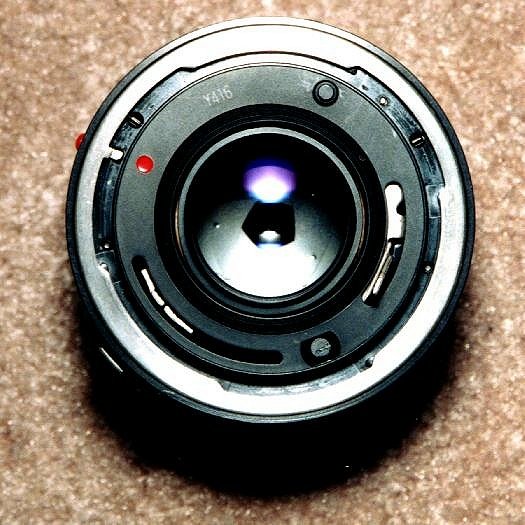
This is a late Canon FD mount, “bayonet” style. The “breech” style Canon FD mount looks similar, but you need to hold your lens so that the top is toward the red dot in the photo for the levers to be in the same position. These fit all manual-focus Canons from about 1970.
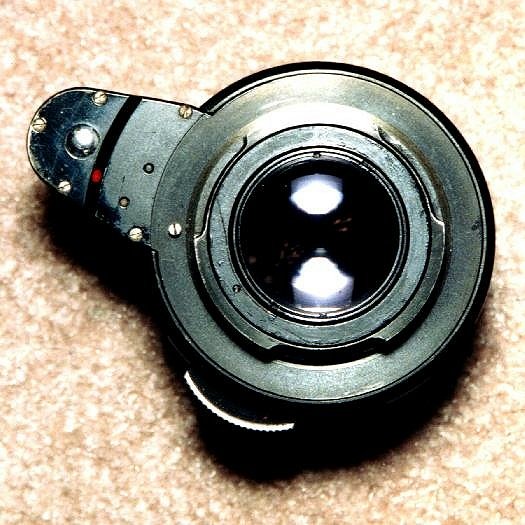
I’m going in alphabetical order here: This is an Exakta mount lens. Most have the protruding arm at the side, but preset lenses and late ones for the RTL1000 don't have the arm. Topcon RE lenses use the same bayonet, without the arm, and have linkage just outboard of the bayonet for the aperture control and the auto-diaphragm.
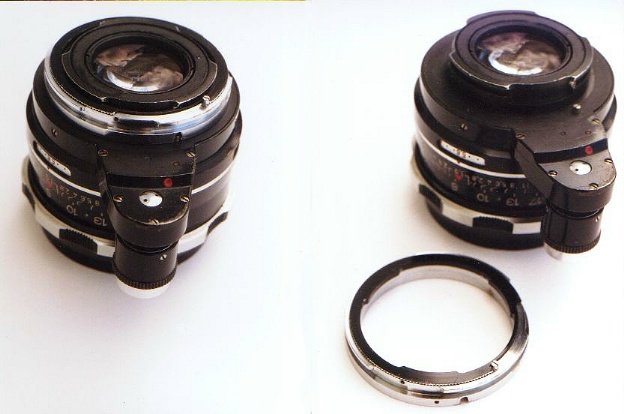
Many thanks to Geoff Steed for identifying this adapter ring: it's one of two "System Rings" that were produced by the West German Exakta organization in the early 70s for the Exakta Twin TL. The Twin TL was made by Petri in Japan, and used the lens mount that had been developed for the West German Exakta Real in the 1960s. The Real and Twin TL came from Exakta Kamerawerk AG, a West Berlin rival of Ihagee of Dresden (in East Germany) who made the "real" Exaktas (confused yet?). None of Exakta Kamerawerk's efforts met with much success, and they are uncommon-to-rare collector's items today. At any rate, this adapter ring allows a Real or Twin TL to accept all standard Exakta mount lenses. The second "System Ring" allowed those same cameras to accept M42 screw mount lenses. Unfortunately, I've never had a camera that fit this adapter ring.
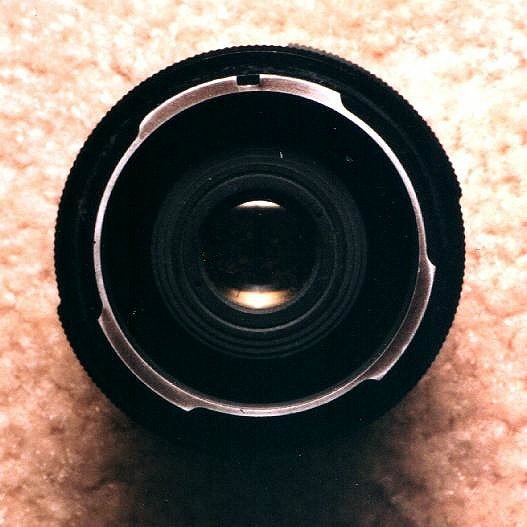
This lens fits the Konica AR series of SLR cameras, which began with the Auto Reflex of 1967 and continued through the end of Konica SLR production. The notch in the top lug of the bayonet is for the latch that holds it on the body. This is a preset lens, so you can’t see the autodiaphragm linkage levers that would be on most Konica lenses (sorry…)
There was an earlier Konica series, introduced in 1960, which used a different mount called the Konica F mount. The F and AR series are NOT interchangeable. Click on the photo above for a look at examples of both the F and AR series mounts (thanks to Andreas Buhl for this information)
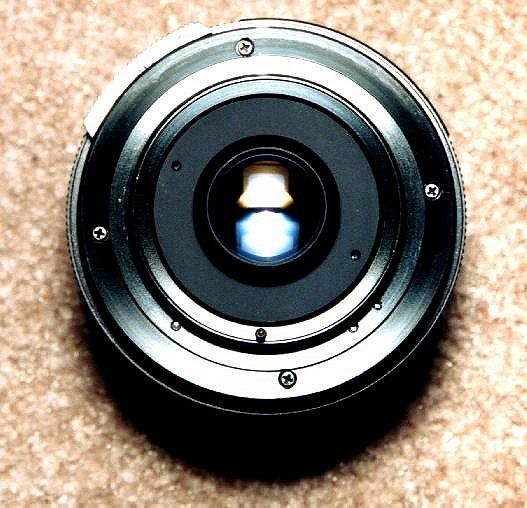
Another oldie, this is the M42 screw mount, also known as the Pentax, Praktica or Universal screw mount. The little protruding pin at the bottom operates the auto-diaphragm; some very early ones don’t have the pin. This fits any screw-mount SLR you're likely to come across, except the M44 Miranda. (Note: the M42 thread is 42mm in diameter with a 1mm pitch. You may encounter a lens with a finer thread, 42mm diameter but about 0.75mm pitch: this would be a “T” mount lens, missing its mount which screws on. With the correct mount, a “T” mount lens can fit anything.)
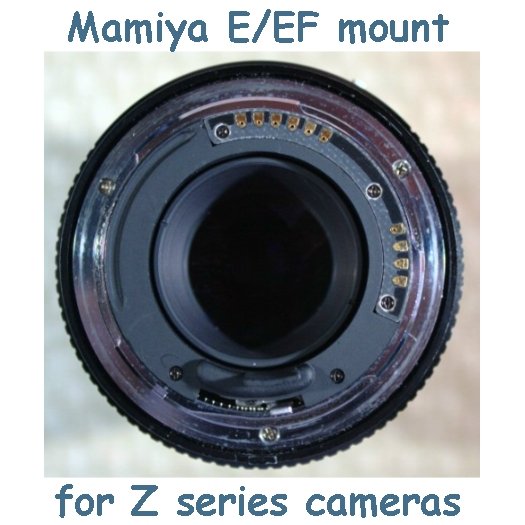
Mamiya is an interesting company. They started out with the M42 screw mount above, and then in 1971 introduced a bayonet mount. Then in 1975 they introduced a DIFFERENT bayonet mount. Then in 1980 they introduced ANOTHER different bayonet mount. This is the last one, which fits the ZE, ZE-2, ZE-X and ZM camera models. With that much uncertainty regarding their design approach, it may not be a shock that Mamiya gave up on 35mm SLRs altogether after that. (Many thanks to Chris Moller for the photo of this mount, which I proved unable to identify)
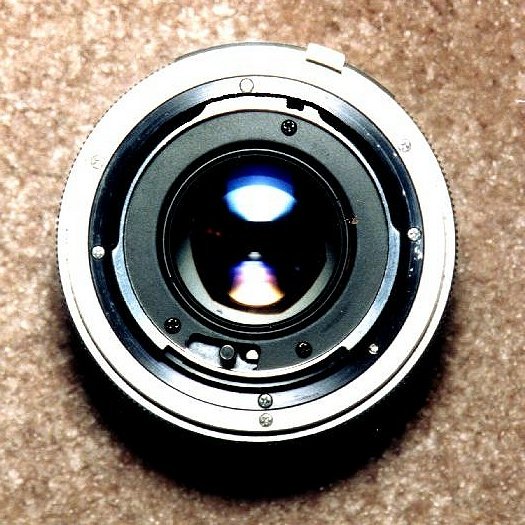
This is the Minolta MC/MD mount. It fits any manual focus Minolta SLR. Like the Konica, Minolta lenses latch with a notch in the top bayonet lug; but note that the notch is near the end of the lug, not nearly centered as in the Konica. The bump on the aperture ring at the top is the coupler for the indexing ring on the body -- similar to the Nikon AI system (but Minolta had it first).
[Note: MC series lenses fit all manual focus Minoltas and support manual and aperture-priority exposure modes. MD lenses fit the same cameras and support shutter priority and program modes in addition to manual and aperture priority]
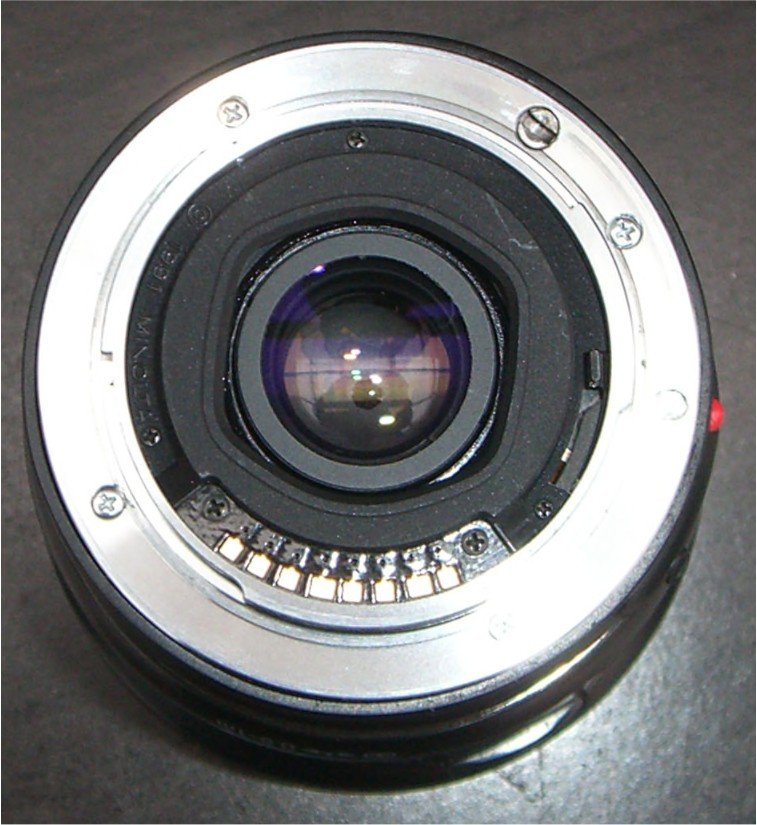
CLICK HERE to see Minolta/Sony AF and digital lens mounts
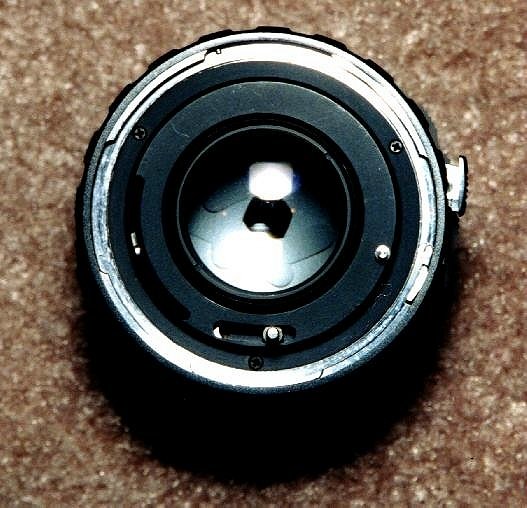
This is the Miranda bayonet. Though all Mirandas used the same bayonet, there were variations in the registering pins on the back of the lens: earlier versions (up to about 1973 or so) lacked the pins which were used for open-aperture metering in later cameras; lenses for the Automex, Sensorex and Sensorex II models have a moving arm on the side to couple the aperture ring to the camera body. Miranda camera bodies also have a 44mm screw-thread mount, inside the bayonet, for special accessories and T-mounts; but the prime lenses are most commonly found in bayonet mount.
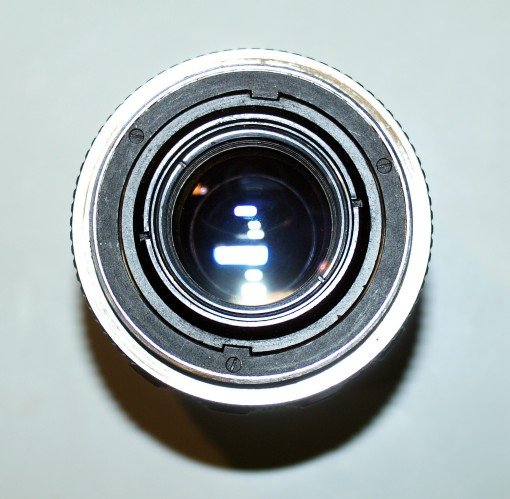
Before the introduction of the Miranda bayonet mount, from about 1955-1960, Miranda cameras used a 44mm thread mount as shown here. The M44 screw thread was kept as part of the bayonet mount design, so that these lenses could still be used on later Miranda cameras. Some new lenses continued to be offered in the M44 screw mount as late as 1967, and it also remained the standard mount for bellows, T mounts, and other accessories that did not require aperture coupling. Many thanks to Menno van der Meer of Spain, both for this photograph of the M44 mount and for corrections to the description.
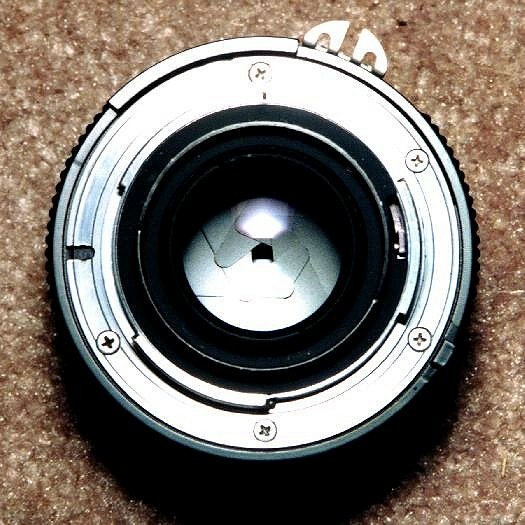
This is a Nikon AI mount. Non-AI is similar, but without the 'stepped' surface at the rear of the aperture ring. This lens can be used on any Nikon SLR, including the new AF models (well, maybe not ALL: Nikon has apparently taken to using electronics to communicate between the lens and the body in some of the latest models, rendering perfectly good older lenses useless); Non-AI lenses must be converted for use on newer (post-1977) cameras, and some cameras can be damaged by attempted use of non-AI lenses. Current Nikon lenses do not have the 'fork' protruding at the top; absence of the fork makes these incompatible with pre-1977 Nikons and Nikkormats.
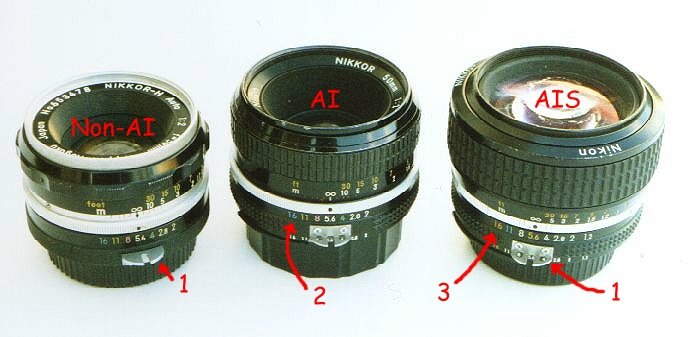
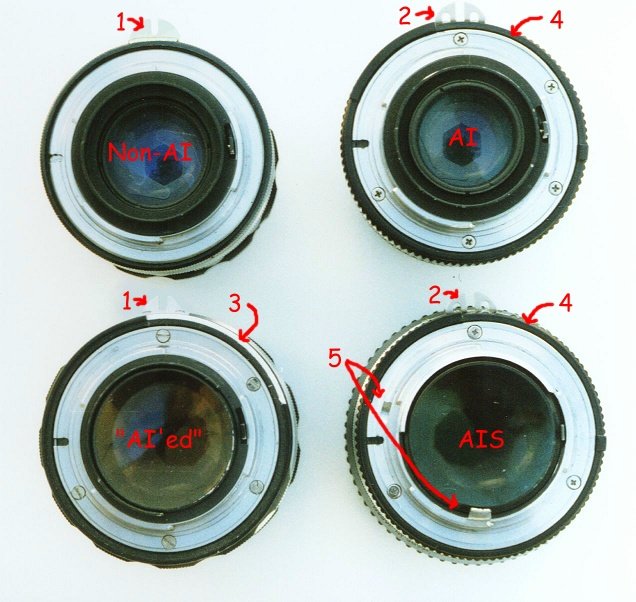
Click here for an explanation of the differences between AIS, AI and Non-AI Nikon lens mounts.
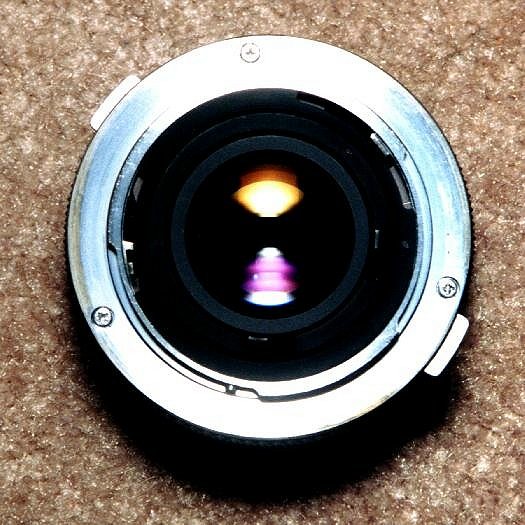
This is the Olympus OM mount. There have never been any variations of this mount; every OM lens fits every OM camera ever made. Note the lens release and stop-down buttons opposite each other, an easy identifying feature of the OM mount.
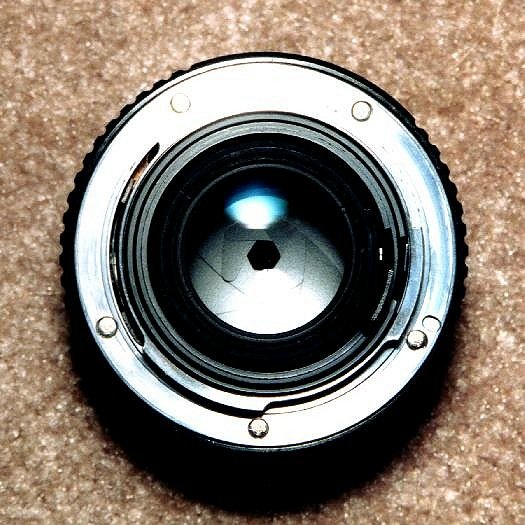
The Pentax K mount was introduced about 1975 and fits all non-screw-mount Pentaxes as well as many Ricoh, Chinon and Cosina cameras. The notch at the lower corner for the lens release lock helps identify this lens (Nikon lenses have a similar notch, but on the opposite side and centered rather than toward the lower corner). Current Pentax AF cameras use the same mount.

This is the Petri lens mount. Petri used this through most of their production, changing toward the end to the M42 mount to take advantage of the availability of third-party lenses in M42 (I don't know if you'll find any third party lenses in the Petri mount). The original Petri breech-lock is a good, wear-proof mount, similar to the Praktina design just below (but not interchangeable with it). Many thanks to Matthew Currie for this photo, complete with explanatory notes.
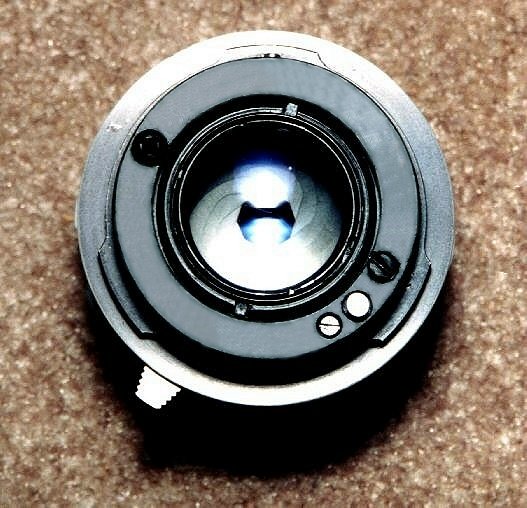
Here’s another oldie: this is the Praktina FX bayonet from the late 1950s. The later IIa model used the same mount but with slightly modified diaphragm operation. No other camera has used the Praktina mount; the Pentacon Six/Praktisix/Exakta 66/Kiev 60 mount is essentially a scaled-up clone of this design.
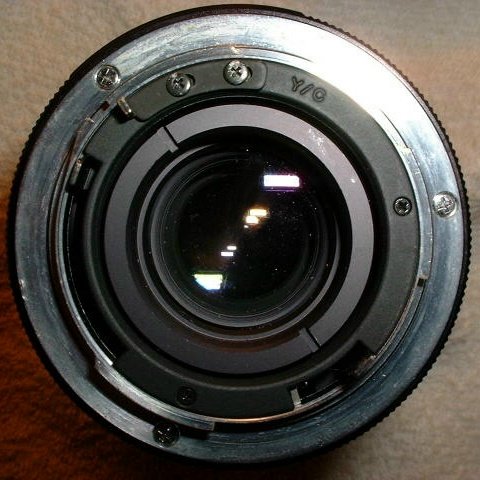
This is the Yashica/Contax lens mount. I don’t own one of these, this photo was donated. The "Y/C" is a dead giveaway here, you won't always be that lucky; but that adjustable little tab thing just to the left of it is something I don't see on other lens mounts…
Interchangeable Lens Mounts:
There are some lenses that don't mount directly to any camera, but have a removable mount that allows one lens to be used on more than one brand of camera. If you run across one of these without the mount attached, here's what it looks like:
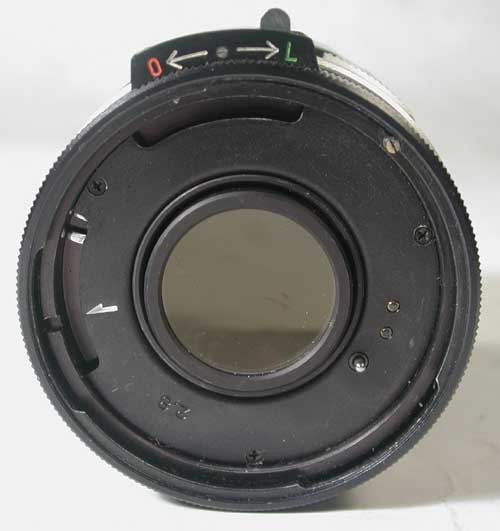
This is the rear end of a T4 mount lens. The later TX mount is nearly identical in appearance, but is marked “TX” on the back surface.
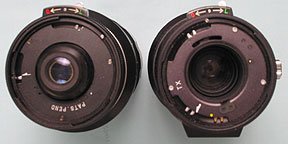
These were made by Vivitar and Soligor in the 1970s. They are very similar, except that the TX mount has the additional linkage to permit open-aperture metering; as I recall, you can use a T4 mount on a TX lens, but not the other way round…

This is the back end of a Tamron Adaptall lens without its mount. Similarly to the T4 and TX, the Adaptall system evolved as the cameras did; this is an Adaptall-2, but the differences are subtle. This system appears only on Tamron brand lenses.

For the moment, this is my only example of a leaf-shutter lens mount. The Retina Reflex and Voigtlander Bessamatic/Ultramatic mounts are identical except for the little tabs and cutouts shown at the red arrows. It's very easy to machine either the body or lens mounting flange to make them fully interchangeable. Here’s how.
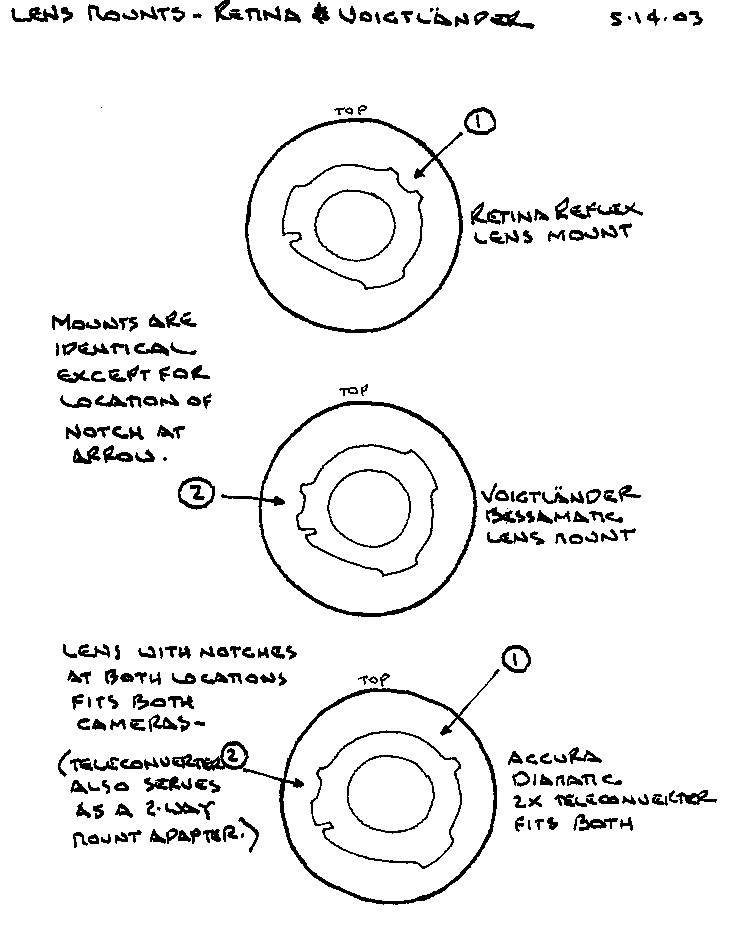
There's not really any reason to include the leaf-shutter lens mounts here, now that I think of it: as far as I know there were no aftermarket lenses made for any of them other than a couple of Retina/Voigtlander teleconverters… so if your lens says "Retina", or "Kowa", or "Topcon UV", that's the camera that it fits.
* * * End of text * * *

Source / Извор: Zeiss.com
Conspicuously missing from this list is the Leica M mount, but that’s not a big problem since Leica lenses are hard to find at flea markets. And besides, that lens mount is characteristic because it is not an SLR mount, and it is very easily recognizable, even if there is no Leica inscription on the lens itself.
Of course, none of these texts are perfect, and neither am I, who collected them here. If you know of an additional or better source, please add it to this post, so that all searchers can have an easier job of identification.
Good luck finding old gems!
* * *
Related posts:
Vivitar 75-260mm f4.5 – A 20 bucks Moon! [eng/срп] Шетња средом – Месец за 20 долара!
A Revolution! At last! (Sony a9 III)
Nikon Zf – The one I could fall in love with!
DPreview going to the void… [eng/срп] DPreview иде у ништавило…
Viltrox Homerun: Pro AF 75mm f1.2 – Dream Portrait Lens! [eng/срп] Вилтрокс у центар: Про АФ 75mm f1,2 – портретни објектив из снова!
Lomo DigitaLIZA Lab [eng/срп] Ломо ДигитаЛИЗА Лаб
Swan Portrait (With a very old lens) [eng/срп] Портрет лабудова (веома старим објективом)
Canon EOS R6 Mark II
Nikon Z30 – Nothing to see here…
Leica M11 – A New Oldie!
Mirrorless 2021
Tamron 18-300mm F3.5-6.3 Di III-A VC VXD – A Perfect Travel lens?
A Nostalgic Magic – Nikon goes Fuji!
New Goodies from Fujifilm!
Remini – Magic of AI
A Monster Killed Pentax!
WednesdayWalk – Street Life (With old lenses) [eng/срп] Шетња средом – Живот улице (старим објективима)
News from a Photo Circus: Nikon Mark II Clowns and Canon Flash Jokers!
EXCLUSIVE LOOK INTO THE FUTURE – Fujifilm X-S10!
Youth Football Training [eng/срп] Омладински фудбалски тренинг
Sony a7C – The Smallest FF cam… well… with EVF
Pentax Principles… in Practice
Nikon Z5 & Clueless Bunch of Camera Designers
Tokina SZX 400mm f8 Reflex MF – Make your mirrorless camera have mirror again!
Principles of Pentax
Canon EOS R5 & R6 – A True Revolution?
Olympus Imaging – The First Victim of Coronavirus
Tutorial: Eterna Bleach Bypass FujiFilm Simulation
Why Aren’t You Winning Photography Contests?
NEW: FujiFilm X-T4 — Closest to perfection!
NEW: Olympus OM-D E-M1 Mark III — Repackaging for Travel?
Fujifilm X100v — A Beauty Enhanced
Fujifilm X-T200 — The Shape of Things to Come
Lens test: Portrait Face-off — Nikkor vs. Canon
Lens test: 35mm Oldies — Nikkor vs. Zeiss
Nikon Z50
Fujifilm X-Pro3 — A Major Design Flop!
Yongnuo YN450 Android Mirrorless Camera… With SIM!
ZEISS ZX1 — Android Full Frame!
The Last of the Mohicans — FujiFilm FinePix XP140
Canon EOS RP — Released!
Leica M10-P ASC 100 Edition
Canon EOS RP
Full Frame Fuji? Don’t Count it Out!
Canon Speedlite 470EX-AI flash
Leica D-Lux 7
Insta360 ONE X — Ultimate Selfie Camera?
Leica Q-P — P for Perverseverance?
Pinhole Photographing — Like a Boss!
Another Blast From the Past — Escura Instant 60s
PHOTO&VIDEO REVOLUTION: New Sensor Technology!
Leica-M10-D — Digital Body. Analogue Soul. Terrible Design
Nano — Offspring of Tiny
Fujifilm X-T3 — Making it Right
Panasonic S1R and S1 Full Frame cameras
Ricoh GR III
Canon EOS R — R For Ridiculous?
Canon EOS R — Specification Leaked
Nikon Z6 & Z7 — Official
Nikon Z6 & Z7 Mirrorles
Crazy Lens — Laowa 24mm f14 Macro Probe
Water Drop Lens & Camera!
Canon EOS M6



Access Hive through Ecency
Приступите Хајву кроз Ecency

Access Hive through Ecency
Приступите Хајву кроз Ecency

Access Hive through On Board
Приступите Хајву кроз On Board

Access Hive through On Board
Приступите Хајву кроз On Board

Bastyon.com

Bastyon.com

Google detox starts here!

Google detox starts here!

Universal Basic Income

Universal Basic Income

Check out ABRA and easily invest in 28 cryptocurrencies or BIT10, an index of the top cryptos. Use this link to sign up and get $25 in free bitcoin after your first Bank/Amex deposit, or 1.5% cash back when you exchange cryptos
 1GZQG69sEKiMXKgGw9TcGcUCBoC4sC1ZYp
1GZQG69sEKiMXKgGw9TcGcUCBoC4sC1ZYp
!PIZZA !WITZ
!hivebits
@mundharmonika mined HBIT. ⛏️ (1/1) tools | trade | connect
Made with LUV by crrdlx.
lolztoken.com
Du hast keine Witze mehr für diesen Tag!
@mundharmonika du kannst @lolzbot maximal 1 Mal pro Tag nutzen.
Level up, indem du mehr $LOLZ kaufst, damit du mehr Witze pro Tag teilen kannst!
$PIZZA slices delivered:
@mundharmonika(3/5) tipped @lighteye
I wish 2024 will be a year I finally buy first digital camera. Sretna ti Nova godina 2024. 🍾🥂❄️☃️
Срећна и теби Нова 2024, @zorank, и нека то буде неки лепи Fujifilm апарат! 🙂